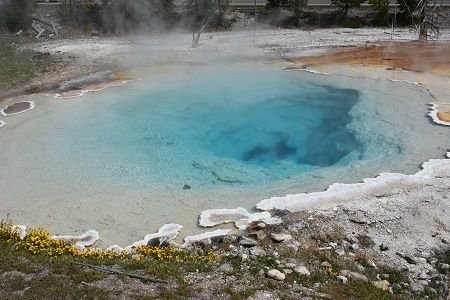Article
Yellowstone National Park's Amazing Geothermal Features
Author(s):
Yellowstone, America’s first national park, harbors the world’s highest concentration of geothermal features, potent symbols of the Earth’s primal forces.

Fountain Paint Pot. Photo: Candyce H. Stapen.
Yellowstone, America’s first national park, harbors the world’s highest concentration of geothermal features, potent symbols of the Earth’s primal forces. Proponents of the park, along with protecting its wildlife, sought to preserve Yellowstone’s geysers, hot springs, fumaroles (steam vents), and mud pots.
Here are some top places to see Yellowstone National Park’s Geothermal Wonders.
Highlights from Yellowstone. Video by Candyce H. Stapen
Old Faithful
Located in the Upper Geyser Basin, Old Faithful, the park’s iconic geyser, isn’t the highest. It’s simply the park’s most predictable, typically erupting every 90 minutes, give or take 20 minutes. Of course, geysers—hot springs with restricted “plumbing” that creates pressure—vent on their own timetable.
Old Faithful, spraying steamy water 100 to 130 feet in the air, is the park’s “diva;” her “performance” is sought out by nearly every visitor. For the least-crowded viewing conditions, arrive by 8 a.m. in the morning, before the bus groups and day visitors or arrive in the evening after those groups leave.
Upper Geyser Basin
Old Faithful isn’t the only geyser or geothermal feature in the park’s one-square mile Upper Geyser Basin. On a stroll of the boardwalk behind Old Faithful, you pass nearly a score of additional attractions. Beehive Geyser, an unassuming mound when inactive, erupts twice daily, shooting a column of spray 130 to 180 feet in the air. Doublet pool, with is edges “scalloped” by geyserite, glows a luminous blue.
Fountain Paint Pot
Located in the 11-square-mile Lower Geyser Basin, Fountain Paint Pot gains fame for its blue pools of water and for the gold and rust streaks that ribbon the ground, created by bacteria and other microorganisms that thrive in the heat. From the boardwalk trail, view mud pots percolating with bubbles; fumaroles belching smoke; geysers spraying water; and hot springs, that despite their high temperatures, appear cool and blue. The path’s highlights include Silex Pool, a sky blue hot spring; Clepsydra, a geyser with a wide, near constant eruption; and Leather Pool, a hot spring partially covered by brown bacteria. To avoid crowds, visit popular Fountain Paint Pot early or late in the day.
Mud Volcano and Dragon’s Mouth Springs
Mud Volcano and Dragon’s Mouth Hot Springs are situated 5.9 miles north of the junction of the road to Fishing Bridge and Lake Village. When pioneers first discovered Mud Volcano in the 19th century, it roared, flinging mud into the nearby trees. These days Mud Volcano resembles a boiling pot, percolating with thick, wet mud. The aptly named Dragon’s Mouth Spring hisses and belches steam.
Mammoth Hot Springs
Most of the other hot springs in Yellowstone flow through volcanic rhyolite rock, but Mammoth’s Hot Springs flow through limestone, the remains of an ancient inland sea. Seeping through cracks at the surface, the hot water deposits calcium carbonate, a white substance also called travertine, that forms terraces on the hillside. The terraces change shape as the water patterns vary and the rust color streaks result from the bacteria and algae in the streaming water.




